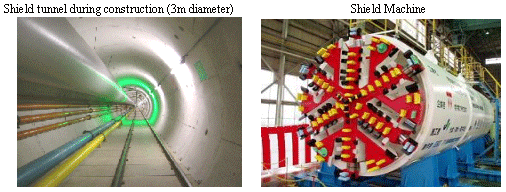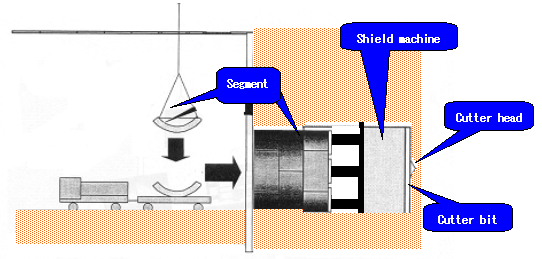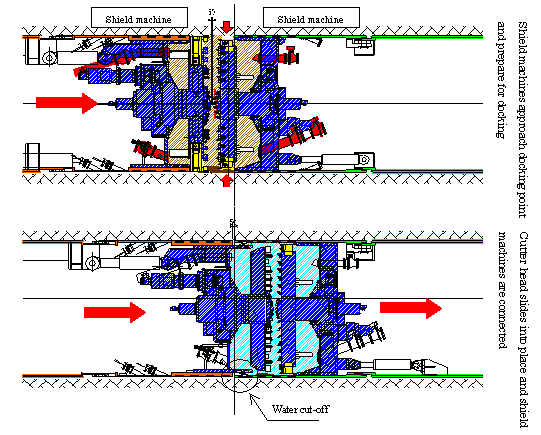Since April of 2003, TEPCO has been constructing the Trans-Bay Gas Pipeline
that will link the LNG receiving terminal of Futtsu Thermal Power Station
and Higashi-Ogishima Thermal Power Station. Construction has been
progressing inwards from both Futtsu and Higashi-Ogishima, and the
excavation of a shield tunnel*1 under central Tokyo Bay has just completed.
The Trans-Bay Gas Pipeline will form a 20km stretch of gas pipline under
the Tokyo Bay connecting the LNG receiving terminal at Futtsu Thermal
Power Station in Futtsu city, Chiba prefecture with the LNG receiving
terminal at Higashi-Ogishima Thermal Power Station in Kawasaki city,
Kanagawa prefecture. The pipeline will establish a gas network linking
the five LNG thermal power stations of Chiba prefecture*2 with the three
LNG thermal power stations of Kanagawa prefecture*3, which will improve
the reliability of LNG supply resulting in a more flexible and efficient
operation.
The connection of the shield tunnel under central Tokyo Bay concludes
2½ years of tunneling. Construction now continues with the laying of
the gas pipeline in the shield tunnel, with commencement of operations
scheduled for March 2009.
State-of-the-art tunneling equipment and technology were used in the
excavation of the shield tunnel, which dramatically improved efficiency
and made it possible to supervise tunneling operations in a stable and
cost-effective manner. Here are some facts about the excavation.
(1)World-largest-class tunneling length
• A world-largest-class tunneling length of 9.0km with the use of a
single shield machine was achieved. (Digging began from Futtsu and
Higashi-Ogishima, and connected under central Tokyo Bay)
• Shield tunneling successfully concluded without having to replace any
parts, including the cutter bit*4, due to thorough endurance studies
testing of the shield machine.
(2)Stable, high-speed construction
• Major problems were avoided and a stable and rapid tunneling speed
averaging more than 500m/month was maintained by using one-pass
boltless joint segments*5 with a short assembly time, fully training
all stations, and closely monitoring construction.
(3)Use of direct docking tunnel method*6
• Work period was dramatically shortened by using the direct docking
tunnel method to connect the shield machine at the extreme water
pressure of 0.6MPa under the Tokyo Bay.
• Precision tunnel shaft surveying and horizontal bore probing from as
close as 50m made it possible to achieve millimeter precision in
aligning shield machines into a straight line.
For the commencement of operations in March 2009, TEPCO will continue to
make safety the first priority in construction. Also, TEPCO greatly
appreciates the continued support and understanding of the citizens of
the area and everyone involved in the project.
*1 Shield tunnel & shield machine
Shield tunnel refers to a tunnel constructed using the shield method.
The shield method refers to a tunneling boring method that uses a steel
cylinder called a shield machine to dig a tunnel through the soil. After
digging a specific distance (1.2 to 1.5m), a concrete liner called a
"segment" is assembled in the shield machine to prevent the wall from
collapsing and to stabilize the tunnel shaft.
Shield tunneling is a safe and rational construction method that has
been used widely in recent years to construct city tunnels for subways,
water and sewer services, gas, communication and power, as well as to
excavate the undersea tunnel used by the Tokyo Bay Aqualine.
 |
*2 LNG Thermal Power Stations in Chiba prefecture:
Chiba Thermal Power Station, Goi Thermal Power Station,
Anesaki Thermal Power Station, Sodegaura Thermal Power Station,
Futtsu Thermal Power Station
*3 LNG Thermal Power Stations in Kanagawa prefecture:
Kawasaki Thermal Power Station, Higashi-Ogishima Thermal Power
Station, Yokohama Thermal Power Station
(for reference) Futtsu LNG receiving terminal :
10 tanks (tank capacity: 1.11 million kl)
Higashi-Ogishima LNG receiving terminal :
9 tanks (tank capacity: 0.54 million kl)
*4 Cutter bit
The cutter head is the device mounted on the tip of the shield machine
that rotates to dig through the soil. The claw that is mounted on the
cutter head to do the actual digging is called the cutter bit. The
cutter bit is made of cemented carbide, which wears down with digging,
so the material must be chosen carefully according to the soil type.
*5 One-pass boltless joint segment
One-pass boltless joint segments are a type of segment used in recent
years to reduce segment assembly time by making it possible to connect
segments by simply inserting a pin.
 |
*6 Direct docking tunnel method
The docking tunnel method is used to mechanically align shield machines
when digging a tunnel so as to minimize soil intrusion. Water is kept
out of any remaining unprotected parts of the joints by using water
cut-off seals. Essentially no additional work is needed, thus reducing
costs and construction period .
 |
 Appendix
Outline of Trans-Bay Gas Pipeline Project
Map of TEPCO gas pipelines and the Trans-Bay Gas Pipeline
|